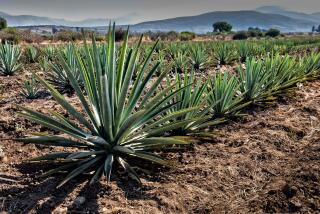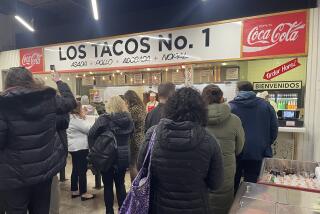In Baja, lazing away by San Quintín Bay
The burnt-orange remnants of daylight brushed across the darkening sky as we unloaded our bags at the Old Mill Hotel and tried to recover from a teeth-rattling three-mile drive off Baja’s trans- peninsular highway.
Before we had finished unpacking, the hotel’s white-bearded proprietor, Jim Harer, shouted across the courtyard.
“Stop by for a beer whenever you feel like it,” he said. “It’s free.”
The offer was an appropriate kickoff to our long weekend in the Baja fishing village of San Quintín: friendly, laid-back and easy on the wallet.
Our destination, about 200 miles south of Tijuana, seemed a little far for a weekend getaway, but my husband, John, and I were curious about life beyond chaotic Ensenada. So one Friday last month, we counted the winding drive down the coast and through inland valleys as part of the itinerary.
With the mandatory Mexican car insurance already purchased from an auto-club office near home, we zipped south from L.A., through San Diego and into Mexico for a leisurely lunch of fish tacos and black bean soup at La Fonda hotel’s El Royal Restaurant near Puerto Nuevo. An hour later in Santo Tomás, we stopped for fuel and lingered in the quirky souvenir shop of El Palomar, a restaurant, motel and RV park.
By the time we pulled into San Quintín (pronounced kin-TEEN) at dusk, we were ready for that beer.
The town, home to 25,000, sits in the middle of a fertile farm region and near a harbor that is a popular base for sportfishing and kayaking. U.S. and British investors tried to develop a wheat farming and flour processing industry here in the late 1800s, but drought drove them away. Mexican farmers had better luck in the 20th century, as evidenced today by the fields of tomatoes, strawberries and olive trees lining two-lane Highway 1 as it approaches town.
On our way to the easy-to-miss turnoff for the Old Mill Hotel, we also passed rows of edible cactus, painted shacks selling cocteles de mariscos (seafood cocktail) and wagons brimming with mangoes, watermelons and oranges selling for a fraction of their price back home.
The Old Mill was worth the dusty drive. Most of the 34 rooms ring a courtyard overlooking the inner leg of U-shaped San Quintín Bay. The place was full of nice touches that we didn’t expect with our $40-a-night rate. Lounge chairs, grills and original gristmill machinery are scattered around the property, and brick fireplaces and tile floors lend a homey feel to many of the rooms, mismatched décor notwithstanding. (Suites as well as dorm-style rooms sleeping up to six people are available for $54 to $90 a night.) Our favorite discovery was a 10-gallon water cooler in our bathroom, although it later proved more necessity than luxury.
Beautiful surf, light lunch
Saturday morning we woke late and wandered next door to the Cannery, a sardine packing plant that has been transformed into a full-service restaurant, bar and dance hall. After a filling but unremarkable breakfast of huevos rancheros and hash browns, we pointed the car toward mountainous peaks framing the spit of land across the inner bay.
The drive led past dormant volcanoes and small quarries to a hilltop view of the deserted shore. Happy we had four-wheel drive and a detailed map (available at the tourist information office in town), John bounced the car down another rocky path to the beach at La Chorera. It was too cold to hang out, but the sight of long, unbroken lines of surf was breathtaking.
Back in San Quintín, an outdoor market offered mangoes, avocados and a bunch of petite bananas. Our total: $1.25. We had withdrawn pesos from an ATM in Ensenada but found that most places accepted U.S. currency too.
Ready for a light lunch, we drove south on Highway 1 about five miles to Cielito Lindo, another restaurant-motel-RV park, this one near the water. Six dollars bought a plate of tacos, burritos and tostadas for two. The salsa was robust and spicy, the chips fresh from the fryer and the corn tortillas as light as air.
A typewritten sign tacked onto the restaurant’s purple wall chronicled its origins. It said Mark Armistead, a Hollywood producer, had built the complex in the early 1960s, fashioning it after a popular, since-closed Costa Mesa watering hole, El Pescador. John Wayne, Ward Bond and Henry Fonda spent lazy days at Cielito Lindo, according to the writing on the wall. Armistead sold the place in the 1970s after the highway to Cabo San Lucas opened, making the San Quintín area “too accessible.”
The rest of Saturday afternoon was consumed with the weekend’s marquee activity: doing nothing. John napped in the room while I took Harer up on his earlier beer offer. He told me he and his wife, Nancy, retired to San Quintín from Seattle nine years ago and have been running the Old Mill ever since.
It was Mother’s Day in Mexico, and our host had warned us that most of San Quintín’s restaurants would be overflowing. Still, we decided to try Jardines Baja, a restaurant recommended by the Harers that required another dusty three-mile drive.
We were glad we went, although a special holiday menu and a harried wait staff probably took away from the usual ambience. Instead of waiting for a table, we ate at the bar. It was a comfortable place to sip margaritas and listen to live guitar while we waited to order. All weekend we avoided tap water, salad and other common sources of stomach ailments for visitors to Mexico, and we had no problems. Our meals at Jardines Baja — sea bass in a flavorful mushroom sauce and grilled shrimp stuffed with crabmeat — were good enough that neither of us cared that the restaurant ran out of dessert.
Diners had a similar que será, será reaction when the lights later dimmed, then blacked out. The staff filled the room with candlelight, and the celebratory meals went on with gusto.
The next morning we learned that the blackout, the result of a transformer blowout, had extended across San Quintín and still hadn’t been fixed, rendering the hotel’s water pump powerless and our bathroom’s water cooler priceless.
We happily continued our do-nothing crusade until midday on chairs by the bay. As we read, a few boats and kayakers drifted in and out of the harbor, and kids prowled for crabs nearby.
After power was restored to the water pump, allowing for hot showers, we returned to the grounds of Cielito Lindo, parked the car and scaled a few sand dunes to reach nature’s version of a treadmill: Santa María Beach. The wide, flat beach extended for miles on either side of us, tidy except for a few tire tracks. The only other signs of civilization were a jogger and the low-rise, pink-and-yellow La Pinta Hotel in the distance.
Back at Cielito Lindo, our early dinner consisted of happy-hour margaritas and jaiba, cracked crab seasoned liberally with Mexico’s version of Old Bay Seasoning.
Monday morning dawned, and with it came our drive home. This time we took Mexico’s Highway 3 north past boulder-strewn hillsides and crossed the border easily at Tecate. Lucky for us, Armistead was right: San Quintín has indeed become accessible.
*
Laura Randall is a freelance writer based in Los Angeles.
More to Read
Sign up for The Wild
We’ll help you find the best places to hike, bike and run, as well as the perfect silent spots for meditation and yoga.
You may occasionally receive promotional content from the Los Angeles Times.






